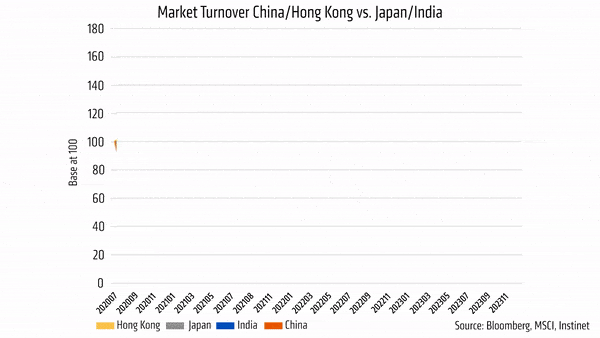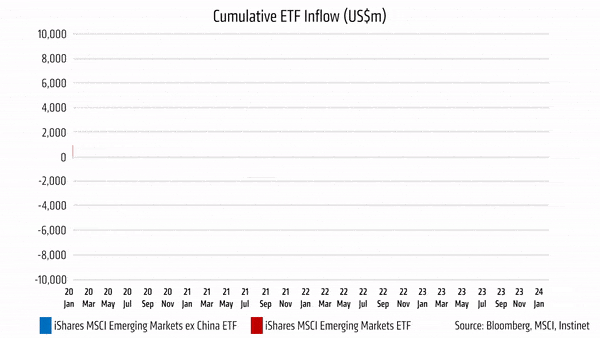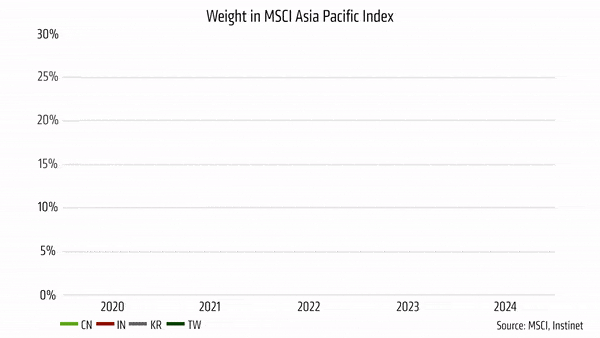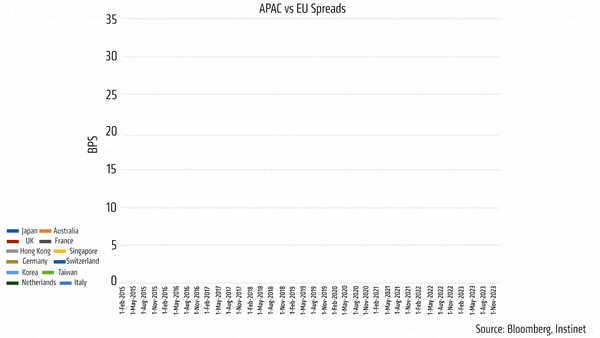What are the main trends you are observing in the Asia Pacific liquidity landscape now? How has it changed over the last few years?
McNiven: Following on the expansion and growth of China Connect for easier foreign investor access to China’s mainland “A share” marketplace, there has been a steady decline of foreign activity in both China Connect and Hong Kong from the peak that we saw in 2021. Hong Kong volumes were down 68% in 2023, compared to 2021. During this time, we’ve also witnessed the beginnings of a large resurgence and keen interest in Japan, attributed to its strong corporate earnings and governance initiatives.
Notably, on 9 January 2024, Japan revived itself to a 34-year high with the N225 Index surpassing the July 2023 peak. Additionally, India in particular over the last two years, along with Korea and Taiwan market turnover has risen. India is largely a growth story with strong prospects and a drastically expanding domestic interest in the equity markets.

Aside from pure market volume and index performance over the last few years, it’s been amazing to see the patterns in ETF inflows and outflows over the same period, particularly in the iShares MSCI Emerging Markets ETFs. Specifically looking at Emerging Market ETFs, you can observe the overall trend of inflows into iShares MSCI Emerging Markets ex China ETF, slowly growing over the last few years. This coupled with a drastic and sharp outflow of the iShares MSCI Emerging Markets ETF, including China, since 2023 through the start of this new year. These are all just a few of the trends that end up creating a dynamic and disperse equity trading landscape.

Within Asia Pacific, where are you observing the most emerging growth and equity expansion? How is this evolving?
Redbourn: As touched upon earlier and showcased below, the emerging market landscape displays a large move away from China by the international MSCI client base, and toward India. In the chart below, you can see the China allocation hit a peak in 2021 at 25% and has since fallen to 17% in 2023. This is nearly the opposite when you look at India’s market weighting, which has been steadily growing and has even doubled in the past few years.
This has further elevated the international client interest that we are seeing in India, especially in the electronic trading space, where we are well-positioned to harness our collaborative Global Execution Services (GES) capabilities onshore and expand our client coverage team. Additionally, our algo development teams have been making enhancements to our underlying platform infrastructure and fine tuning adjustments to ensure that we adapt specifically to the algorithmic challenges and nuances of India and its volume profiles.

McNiven: There are also promising developments taking place in Singapore from a location perspective. We have seen more buy-side growth occurring there with trading desks becoming more regionalised and some traders migrating there under new entities. There are also new Asia Pacific trading desks being launched and staffed as part of brand-new regional office openings. We’ve similarly adopted a larger footprint in Singapore prime to tackle the trend with key members of our leadership based there, including not only Jimmy, our head of electronic trading, but also our head of high touch sales trading (AEJ), along with a senior and growing coverage team.
How has adjusting to this liquidity trend caused shifts among both the buy-side and sell-side?
McNiven: The Asia Pacific equity markets are continuously evolving with each unique market microstructure and the various dynamics of the marketplaces. India in particular has seen changes due to domestic retail and domestic investors, but also with regard to issues surrounding quote to fill times, how blocks are executed, the lack of a closing auction, and exchange sponsored iceberg order types. As mentioned before, all of these aspects invite deep dives into algorithm logic and continuous consulting engagements with clients. Additionally, for Japan’s rise, which also happens to be a market where dark pools are prevalent, we’ve seen a more granular approach to dark pool executions, counterpart engagements on fills, and fill mark outs, than we had in prior years – and with a wider breadth of participants.
Redbourn: We have seen a shift in a larger breadth of clients on the buy-side becoming more active in the microstructure nature of equity trading, from measuring quote to fill times in markets and algo reactions, to deep analysis of Nomura’s NX dark pool in Japan, and the counterparties and mark outs involved. Thankfully, a lot of these microstructure and minutia areas to equity trading in Asia Pacific are also areas where we thrive in providing value for our clients and we enjoy communicating on these topics to more participants. At Instinet, the quantitative trading services and execution consulting teams are a strong part of the coverage model we have developed to ensure we are providing our client base with what they need.
How do issues around fragmentation of the marketplace in Asia compare with those faced by Europe?
McNiven: The Asia Pacific equity marketplace is more regionalised and country centric than the EMEA region. Each country in Asia Pacific’s marketplace has distinct trading market microstructure characteristics. These characteristics evolve with changing investor sentiment and domestic investor impacts in particular, as we’ve seen over the last four years.
The chart below illustrates two main points. One point, is that the cluster of EMEA markets with consistently low spreads and patterns is aligned, compared with Asia Pacific’s much higher average spread costs across all countries. The other point, is that the spreads in Asia Pacific at a country level are changing over time.
Redbourn: For example, Hong Kong’s cost of trading has increased on the back of higher spreads, lower volatility and volumes. Meanwhile, Korea’s spread has interestingly come down slowly over the course of 2022-2023 as the Regulator has tightened short selling, making the potential for foreign quant clients harder as a participant in the market.

How is Instinet providing clients with the right tools to perform? What is unique about Instinet’s solutions that differentiates it from other offerings in the market?
McNiven: As diversification at the country and individual stock level continues to rise, having a ridged tier or cluster profile may not always be best, especially as changes can happen on any given day and within individual countries and sectors. As we continue to solve for our clients evolving challenges and help them perform, we leverage our dynamically updated Micro Adaptive Sequencer (MAS) platform that allows us to be highly efficient, nimble, and responsive to client specific needs and requirements. With machine learning capabilities and dynamic optimisation built in, MAS is a model that also runs on a real-time basis. It sits on top of multiple tactics and determines key inputs like scheduling, profiles, and aggressiveness by utilising multiple factors – which can vary from client to client. It’s a framework we’ve built not only to drive performance improvements, but also support responsiveness to client-specific objectives and flows. With MAS, we can organically include historical observations and real-time overlays, using machine learning based models to combine the inputs into a cohesive instruction to an underlying algorithm for our clients.
There are unique values with MAS, some of them being that it considers all trading constraints and components (not just simply price or volume predictions), and it is continuously optimising based on a stock-specific live time component where not only results of fills, but predictions on different factors faired – are set for the next set of trading events. As we mentioned prior, clients have become more interested in understanding volatility and spread pattern changes, and we have spent time bringing more transparency to them on the results, as well as – importantly – simplifying what factors are included in the optimisation, and how the continual process works.
As sourcing quality block liquidity remains one of the most critical challenges for clients trading in Asia Pacific, a significant priority for Instinet is the further expansion in the region of our electronic crossing platform, BlockCross. We successfully launched in Hong Kong and ASEAN last year and will be going live in Japan and Australia shortly. The seamless blotter-integrated access to Instinet and Nomura’s depth of differentiated liquidity inside our dark pools, respectively Instinet BlockMatch and Nomura NX, has driven strong uptake from clients who are keen to execute sizeable blocks, efficiently and anonymously. Next up on the rollout, are the ID markets. Ultimately, all of the tools and innovations we develop at Instinet are focused on delivering value for our clients with quality execution outcomes and performance, wherever they are based or trade.